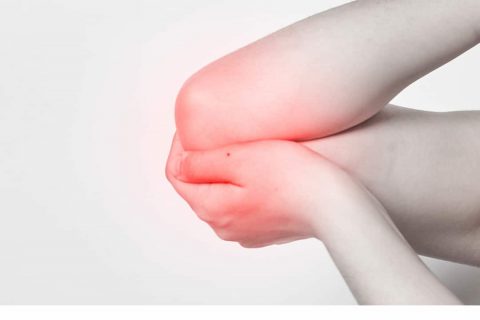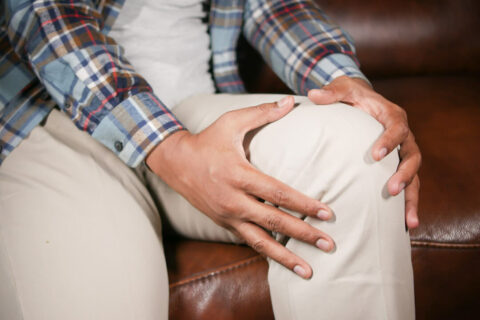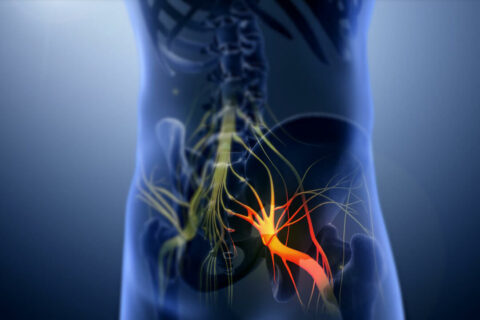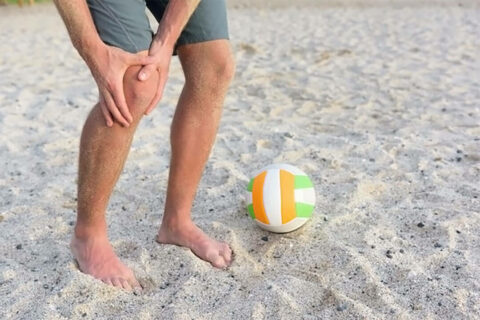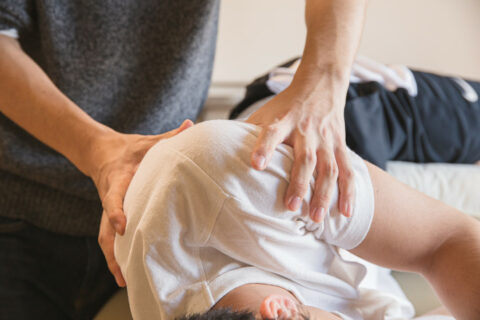What is the proper way to sit at a workstation?

This is a common question because many office workers complain of neck, shoulder or back pain after sitting all day at their workstation. The first thing to understand is the relationship between posture and pain and why prolonged sitting can be a potential problem. Understanding the mechanics involved will give you more motivation to change your work habits.
Postural affects:
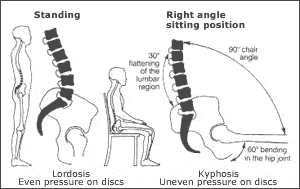
When you sit this arch is reversed somewhat (and made worse when you slump in a chair). The muscles start to become less active in supporting the spine and eventually the support role shifts to the ligaments and discs. Over time this puts a sustained stress through these supporting structures which becomes worse the longer you sit in one posture. A feeling of achiness in the lower back can then develop and you feel like you want to shift around in the chair to bring some relief. It is not uncommon for those with disc injuries to be unable to sit for even short periods of time
Most ergonomic chairs have some form of lumbar support to help maintain the curve in your lower back while sitting, which can help alleviated some of the discomfort.
Postural stress affects the whole body.
Postural stress is not only confined to your lower back. Remaining in the same position for extended periods of time can cause muscles to be constantly tense, especially those in the neck and shoulders. Often tight bands can develop in muscle tissue which become painful over time. Because of this, it is not uncommon for people to develop soreness and pain in the neck and shoulders and even develop severe tension headaches as a result of a poor or prolonged sitting position. Stretching can often help to alleviate the tension but in some cases, they become so painful and tight that a therapist is needed to reduce tension.
So, what is the best posture to adopt to stop all this happening?
In the good old days and still, to an extent these days, the advice has been to adopt some specifically upright posture with everything at right angles, chest out shoulders back etc. This usually worked for about 10 minutes until you had an uncontrollable urge to move. Research has shown that no single ideal sitting posture exists. Our bodies are designed to cope with a variety of movements but not so good at sustaining one posture for a lengthy time. The best way to alleviate postural strain is to change your posture often. This has the effect of migrating the loads from one tissue to another which helps to relieve stress on the back and stops muscles and ligaments from being overloaded.
No Ideal Posture.
Having established there is no ideal posture it is still a good idea to start in fairly good posture and then change from time to time. Here are some tips for beginning your day in the office chair with correct monitor position.
Chair Position:
- Adjust the seat height so your feet are flat on the floor and your knees equal to, or slightly lower than, your hips. Push your hips as far back as they can go in the chair.
- Adjust the back of the chair to a 100°-110° reclined angle. Make sure your upper and lower back are supported. If you have an active back mechanism on your chair, use it to make frequent position changes.
- Adjust the armrests (if fitted) so that your shoulders are relaxed. If your armrests are in the way, remove them.
Monitor Position:
- Place the monitor directly in front of you. By doing this it prevents you from twisting your head and neck when viewing the screen.
- Adjust the monitor height so that the top of the screen is at or slightly below eye level. Your eyes should look slightly downward when viewing the middle of the screen.
- Position the monitor no closer than about 50cm from your eyes. A good rule of thumb is an arm’s length distance. The larger your screen, the more distance you will want.
Pauses and Breaks:
Once you have correctly set up your computer workstation use good work habits. No matter how perfect the environment, prolonged, static postures will eventually take a toll on your body.
- Take short 1-2 minute stretch break every 30 minutes. It can be as simple as stretching your arms above your head and rolling your shoulders a few times each way. After each hour of work, take a break or change tasks for at least 5 minutes. Always try to get away from your computer during lunch breaks.
- Avoid eye fatigue by resting and refocusing your eyes periodically. Look away from the monitor and focus on something in the distance.
- Rest your eyes by covering them with your palms for 10-15 seconds.
Further Issues:
In addition to attending to postural demands, there are a few other things that can affect or exaggerate postural pain. These include sleep, mental health, dietary intake and exercise habits.
Sleep is how the body repairs itself and gets ready for the next day. Researchers have found that non-restorative sleep, or feeling unrested upon awakening, was a major factor contributing to widespread pain. The importance of good restorative sleep cannot be overstated.
The stress response is basically hyperstimulation. In this state the body maintains muscular tension which exacerbates any postural stress already present from work demands. It can also cause an increase in the inflammatory reaction within the body which further exacerbates pain.
Dietary intake concerns what we put into our mouth. Basically, processed foods (especially cakes and biscuits), high caffeine and alcohol intake and any food containing a high amount of sugar will cause widespread inflammation in the body and inhibit the body’s repair mechanisms. This all contributes to muscle pain. Including fresh fruit and vegetables and fish in the diet can be beneficial.
Engage in regular exercise outside work hours. Research has consistently shown that regular exercise goes a long way to relieving postural pain. It does this by increasing blood supply to muscles and joints and restoring overworked postural muscles. Further, exercise can mitigate the ill effects of stress by inducing a feeling of well being and reducing harmful inflammatory actions in the body.
Remember, motion is lotion so keep moving!

